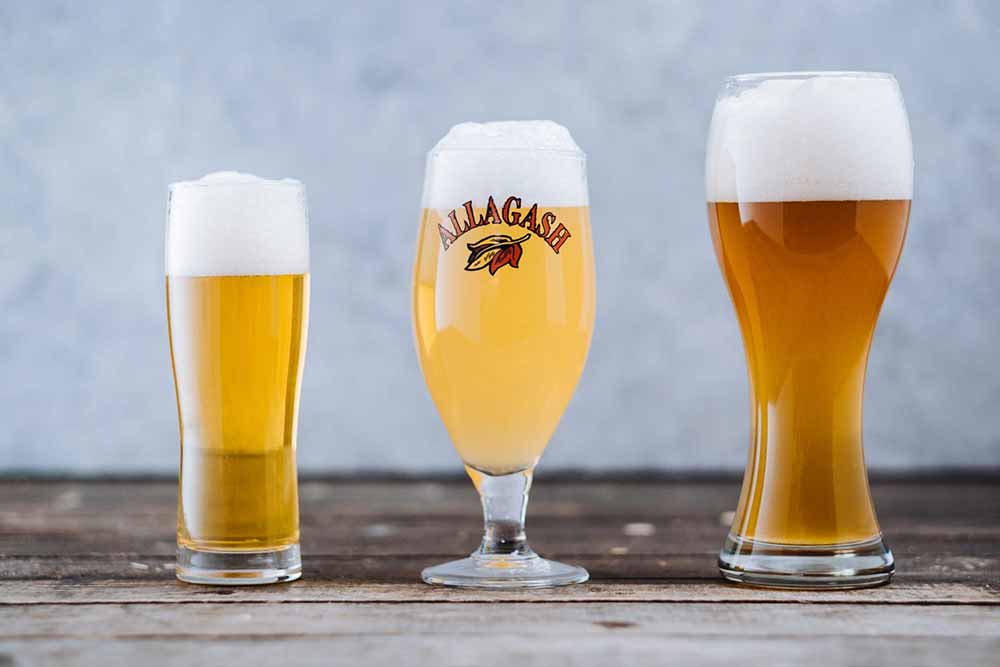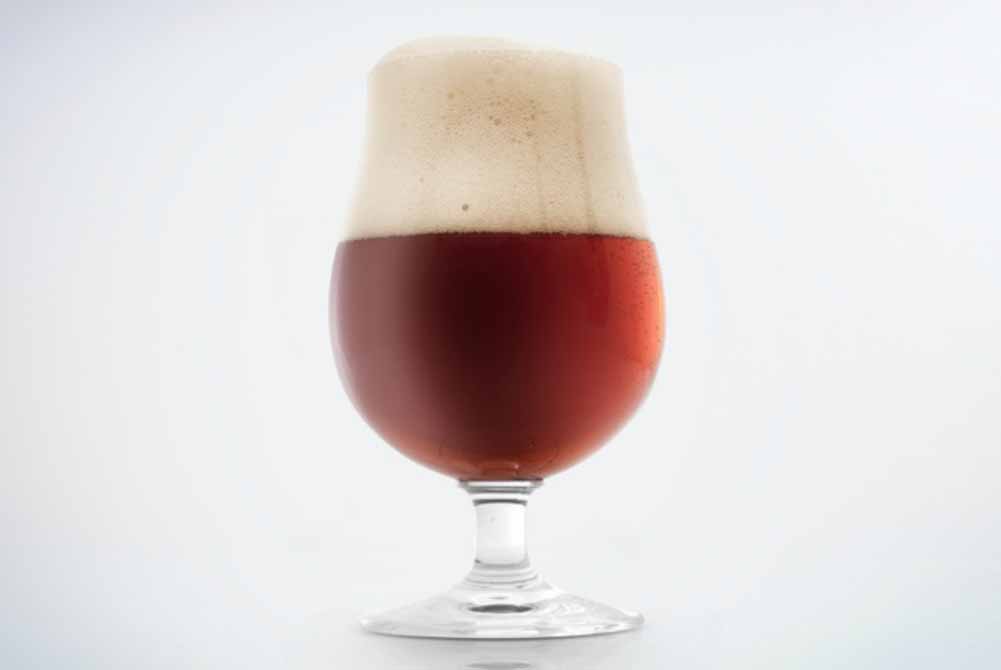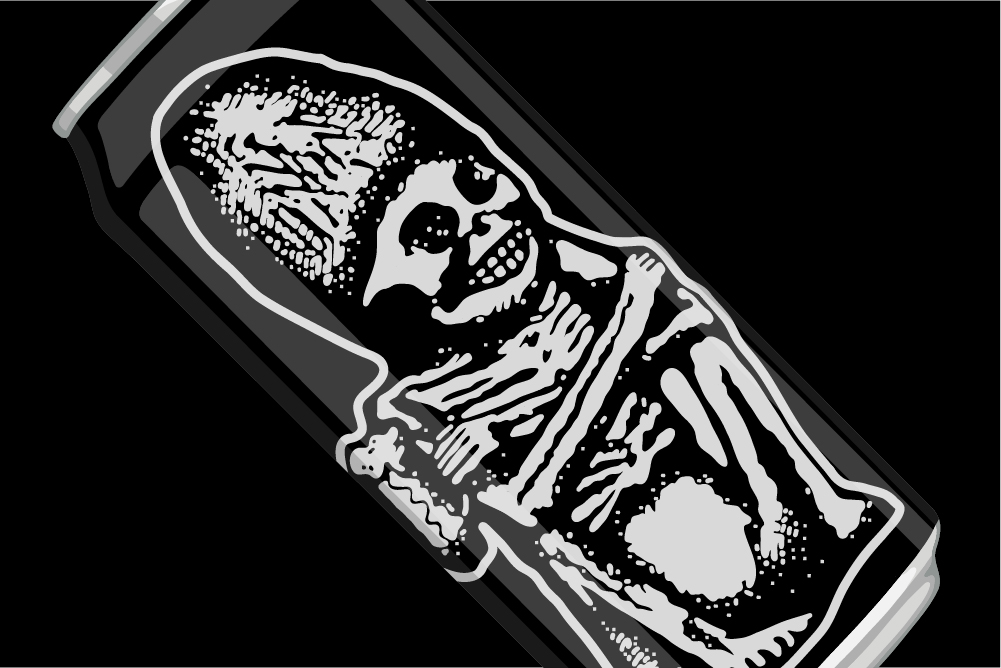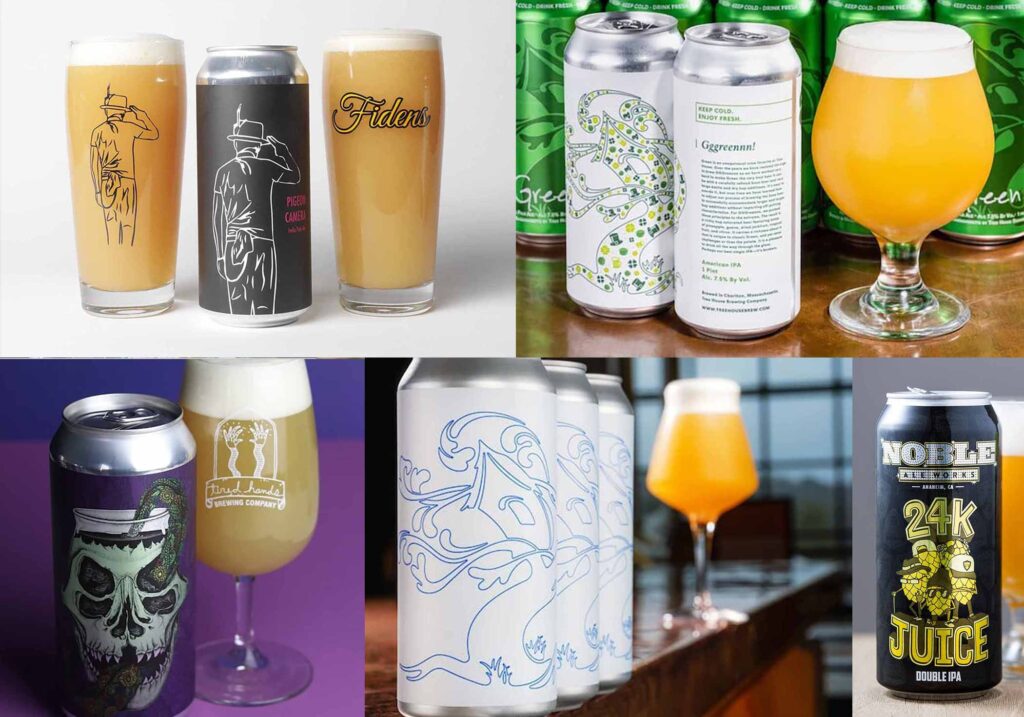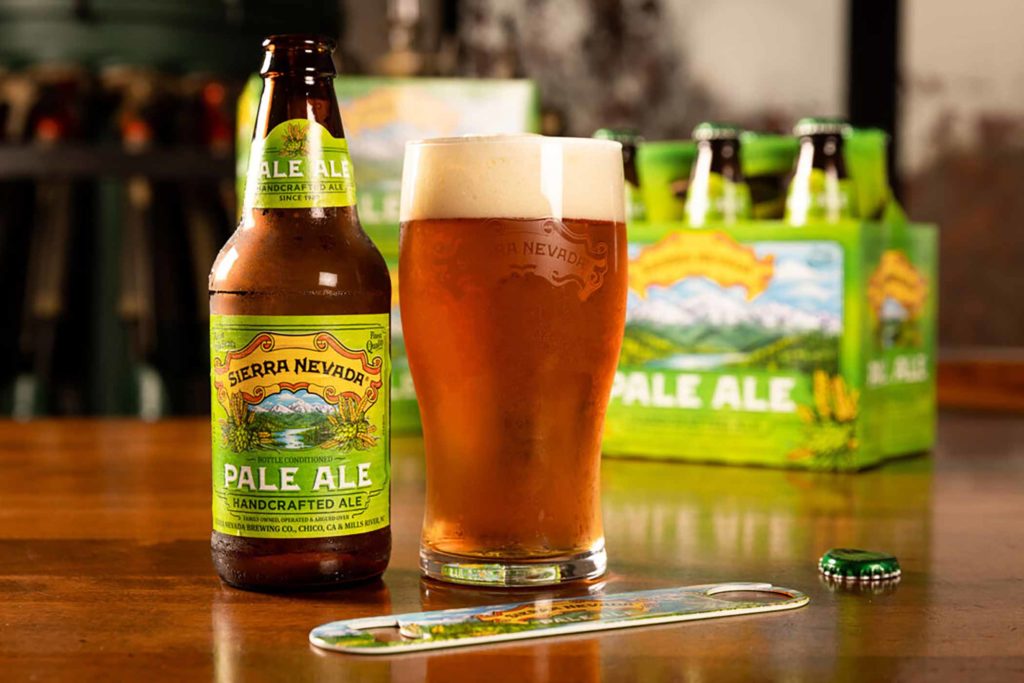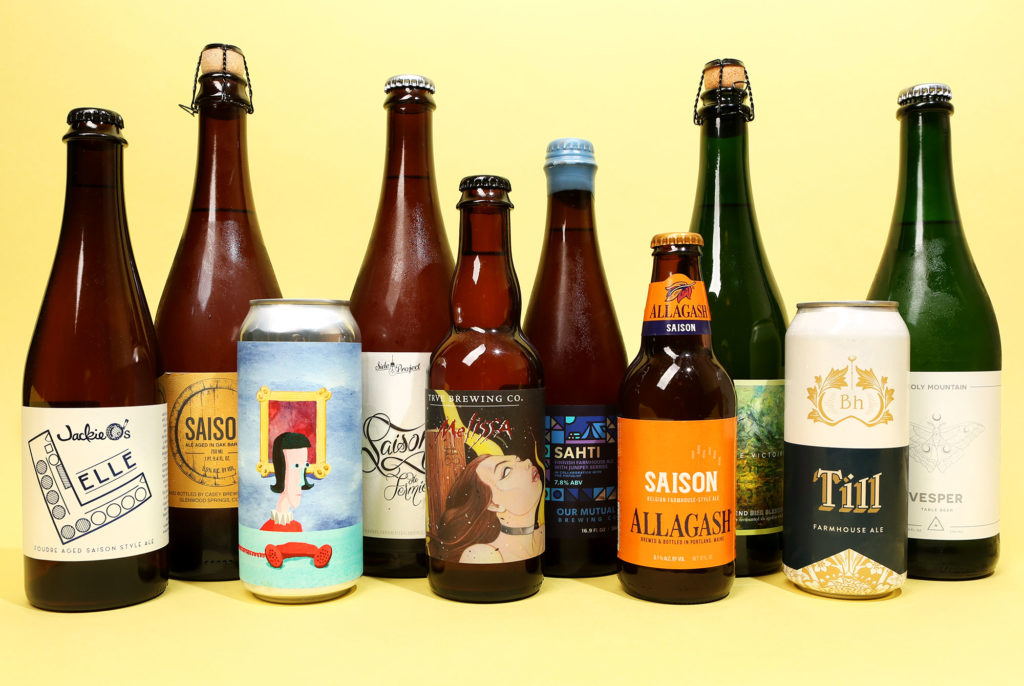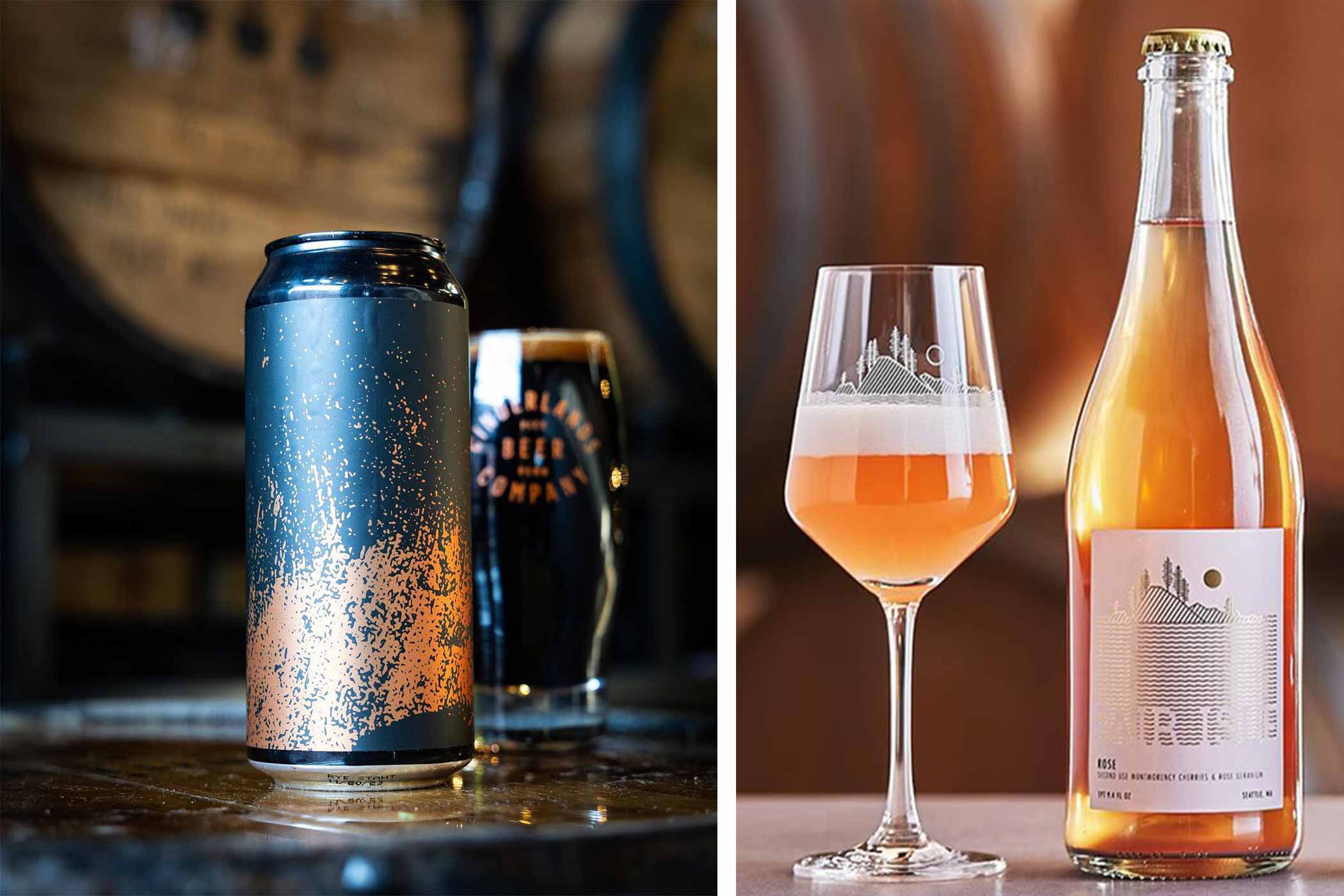Shop
The 27 Most Iconic Beers to Drink in Spring 2024
Looking for More of the Best?
If April showers bring May flowers, then perhaps in our world (and yours, too), April saisons bring May…bocks? In the past, some of our favorite pieces to put together included ”The Best Beers to Drink in Spring,” ”The Best Beers to Drink in Summer,” ”The Best Beers to Drink in Fall,” and “The Best Beers to Drink in Winter.” We’ve run this series back for a little over three years now, so for 2024, we wanted a little more.
Introducing our series on The Most Iconic Beers to Drink Each Season. For all of this content, we’ll identify what we feel are the top five styles that pair best with the time of year, identifying the most iconic (and widely available) beer to drink in that style, along with a few other recommendations.
So, while this list may look a little smaller than similar seasonal pieces in the past, it will also include more beers accessible to a broader audience.
But hey, we’re just giving this a shot. Prefer the past format? Want to see more beers in the future? You can always drop us a line in our DMs or shoot us feedback at [email protected].
Our Most Iconic Beers for the Spring of 2024
Witbier / Wheat Beer
Wheat! In other words, not for the gluten-intolerant, wheat beers and their ilk—witbier, hefeweizen, etc.—feature a malt bill with a good chunk of this grain. Often cloudy and characterized by a specific yeast strain, sometimes with additional accompaniments such as coriander and orange peel, wheat beers give us that pleasant sweetness and uber quaffability (did we just make up a word?) that make them perfect for the temperate spring.
For quick reference, American wheat beers typically feature a grist of at least thirty percent malted wheat and neutral ale yeast, creating a fluffy, fantastically opaque beer that, although thirst-quenching, doesn’t have some of the characteristics of its European counterparts.
For instance, witbiers, Belgian wheat beers brewed with unmalted wheat and spices such as coriander and orange peel. Those adjuncts give witbiers their distinctive slightly spicy note and citrus sweetness.
Or hefeweizens, German-style wheat beers that get their striking flavors—sometimes bubblegum, sometimes banana, sometimes even black pepper, or a combination of the three—from a unique Bavarian yeast. Unlike witbiers, which include extra ingredients, hefeweizens get all those complex flavors straight from the yeast.
Allagash White — Allagash Brewing Company
Portland, ME
Witbier – Often regarded as the pinnacle of Belgian witbiers here in America and around the world, Allagash White has won numerous awards, including nine gold medals (five at the Great American Beer Festival, three at World Beer Cup, and one at European Beer Star), two silver medals, and three bronze ones.
But this beer has quite a history. And people didn’t always want to drink the brewery’s now-best-selling beer. Yes, that’s right—when Allagash Founder Rob Tod introduced Allagash White in 1994, imports still reigned supreme. Craft-wise, beers breaking the standard included Sierra Nevada Pale Ale, Anchor Steam Beer® (which had been around for, well, quite a while), and Boston Beer Co. Boston Lager, for instance.
In the 1990s, Tod worked as a keg washer at Otter Creek Brewing when a Belgian-style witbier called Celis White eventually inspired him to start his own brewery. In 1994, Tod created Allagash Brewing Company from a warehouse in Portland, ME.
After many trials, Tod released his own Belgian-style witbier, Allagash White.
Ironically, only a few people appreciated the witbier for the first ten years. Today, it seems silly to include “stubborn” in the same sentence as Allagash’s current best-selling White. However, during the 1990s, no one understood Allagash’s first beer.
But Tod stuck to his guns. He solely brewed Allagash White, shopping it around to anyone who would listen.
During the early 2000s, Allagash finally grew, but not in the way you’d expect. Because White wouldn’t sell at home, Tod and Allagash Brewmaster Jason Perkins took their beer into as many states as possible. Finally, people’s perceptions and palates changed after ten years of hitting the road. Somewhere between 2006 and 2007, consumers came to understand and appreciate the nuances, spices, and appearances of Belgian-style beers. Slowly, Allagash White became Tod’s namesake, evoking the family, passion, caring, and innovation that Allagash now counts as its core values.
Now, the traditional Belgian witbier ingredients—Curacao orange peel, coriander, and one undisclosed spice—Tod and Perkins use in Allagash White have made it one of the most iconic beers in the country.
As the brewery’s flagship, Allagash White has, as we mentioned, won multiple awards and has become a “go-to gateway” to craft beer.
Buy This Beer In The Untappd Shop
Other Iconic Witbiers / Wheat Beers to Consider
????Bell’s Oberon Ale – American Wheat Beer – The beer that signals spring, Oberon started after former Bell’s President and Founder Larry Bell decided to make a beer to reflect the season, pulling inspiration from Belgian saisons. Over thirty years later, this American wheat beer remains a classic and celebrates the first signs of spring when released every year in March.
????Tröegs DreamWeaver Wheat – Hefeweizen – Perhaps unsurprisingly, a trip to Germany inspired Tröegs Co-Founder John Trogner to make DreamWeaver Wheat, Tröegs’ version of a hefeweizen. Building on a simple recipe picked up during Trogner’s time in Germany, Tröegs uses a blend of red and white wheat to balance the flavors and textures of its hefeweizen. This version sways a bit heavier on the black pepper and clove flavors.
????Alaskan Brewing Co. White – Witbier – Based on the Belgian-style witbiers, White gets a unique dose of Alaska’s glacier-fed water. Originating from the 1,500-square-mile Juneau Ice Field, the water Alaskan Brewing Co. adds to White gives this beer an incredibly unique profile. Alaskan Brewing Co. also adds a blend of European and Pacific Northwest hops. Altogether, White pours hazy, courtesy of those wheat proteins, for an effervescent, smooth, and slightly complex citrus palate, for an elegant beer great in warmer weather but truly delicious in any season.
????Dogfish Head Namaste White – Witbier – Dogfish Head Co-Founder Sam Calagione built his name on beers brewed with culinary inspiration. Dogfish Head Namaste White falls perfectly into that mantra. Brewed with dried organic orange slices, fresh-cut lemongrass, peppercorns, and a bit of coriander, this witbier includes all the fixings of the classic style and then some. Originally a tribute to Dogfish Head’s friends at 3 Fonteinen Brewery in Belgium, Namaste White has all the trappings of a witbier plus a Rehoboth Beach twist for a thirst-quenching ale Dogfish says is “bursting with good karma.”
????Weihenstephaner Hefeweissbier – Hefeweizen – Today, the German brewery Weihenstephaner, which calls itself the oldest brewery in the world, makes one of the best and most referential hefeweizens in the world. Brewed according to centuries-old traditions on the Weihenstephan hill, Hefeweissbier is an epitome of the German style, pouring golden-yellow with a fine head of white foam, smelling of cloves, and with a refreshing, full-bodied, yeasty banana flavor. If you want the classic German version, you can’t go wrong with one from one of the most historic breweries in the world. A winner of numerous awards, Weihenstephaner Hefeweissbier is the epitome of a German hefeweizen, which is probably why it gained 2,337 five-star check-ins on Untappd in 2023, making it one of the most-checked in beers of 2023!
Bock
Translating to billy goat in German, bocks are a vein of lagers dating back to the fourteenth century. Originally from Einbeck, Germany, bocks traveled south to Munich during the seventeenth century, where the subtle language differences meant Bavarians started to mispronounce the style as ein bock.
These lagers encapsulate several different beers—helles bock / maibock, single/traditional bock, and doppelbock—ranging from lighter and pale to darker and heartier.
For the spring, you’re probably looking for a maibock, the lighter, paler cousin of traditional bocks. According to the Beer Judge Certification Program (BJCP) definition, helles bocks are “a relatively pale, strong, malty German lager beer with a nicely attenuated finish that enhances drinkability. The hop character is generally more apparent than in other bocks.” Pouring a deep gold to light amber, these beers represent the spring (Mai means May in German). For that reason, you’ll find a robust malt character and a heavier hop presence than in other bocks.
But you could also enjoy a single/traditional bock, the slightly darker lager that acts as the godfather to all these other bocks. Historically, according to the BJCP, bocks are “a dark, strong, malty German lager beer that emphasizes the malty-rich and somewhat toasty qualities of continental malts without being sweet in the finish.”
If Punxsutawney Phil sees his shadow and brings six more weeks of winter, you might still be reaching for a doppelbock, the darkest of all bocks with a predominantly sweet, rich, malty presence.
For a full breakdown, check out our handy guide to bocks.
Dead Guy Ale — Rogue Ales
Newport, OR
Helles Bock/Maibock – A super popular beer at Rogue, Dead Guy Ale came into the brewery’s portfolio in 1990. First brewed for a Day of the Dead celebration, Dead Guy’s unique artwork draws people in. But it’s the beer that captures their taste buds.
Dead Guy includes Munich for maltiness, a little bit of Crystal 15 malt for color, and 2-row malt for the base. But the beer is complemented by Perle and Sterling hops. “Those are America’s version of Hallertau, Mittelfruh, and Saaz,” Rogue Ales Brewmaster Josh Shields told us. “Sterling is more like Saaz for a nice lightly spicy finish, and Perle is used for bittering.”
He continues, “Expect big maltiness, especially because of the Munich malt and nice, almost sweet finish but balanced out with just enough hops so it’s not cloyingly sweet. Dead Guy pours light amber with an off-white, thick head, finishing with a nice crisp hop bitterness and a touch of spicy hop notes.”
According to Shields, fifty percent of their customers say Dead Guy is their favorite beer. “Many people say it’s their go-to even though they like IPAs,” he says. “You’ll like this beer because it’s pretty approachable for everyone.”
Buy This Beer In The Untappd Shop
Other Iconic Bocks to Consider
????Great Lake’s Brewing Company Rockefeller Bock – Single/Traditional Bock – The classic version from Great Lakes Brewing Company showcases the true power of a traditional bock. Rich and malty, Rockefeller Bock should be your go-to for an American version of this classic German beer.
????Ayinger Maibock – Helles Bock / Maibock – To celebrate spring, Ayinger’s Maibock pours a lighter gold with a malty backbone tempered by a Noble floralness from the Hallertau hops. This beer accurately represents the style and is typically only served seasonally starting at the beginning of March.
????Tröegs Troegenator Doublebock – Doppelbock – Again, for spring, you’ll most likely want to stick to maibocks and bocks. However, if there is still a wintry chill in the air and you’d like something maltier, this version from Tröegs is an absolute classic. As Tröegs writes in its Troegenator Doublebock description on Untappd, “Thick and chewy with intense notes of caramel, chocolate, and dried stone fruit, ‘Nator (as we’ll call him) serves as a tribute to this liquid bread style.”
Buy This Beer In The Untappd Shop
????Hacker-Pschorr Hubertus Bock – Helles Bock / Maibock – According to the beer’s Untappd description, “This Maibock pours a rustic yellow with aromas of semi-sweet malts, grainy and underlying noble hops.” It’s a German classic.
????Schilling Burkhart – Single/Traditional Bock – The incredible lager-forward brewery’s interpretation of a German-style lager, Burkhart features that predominant malt profile—dark rye toast and Werther’s hard caramel candies—followed by that classic soft hop bitterness. A beautiful balance belies a hearty beer best drunk in the dregs of fall. While this beer ranks in the top ten of Untappd’s all-time highest-rated single bocks, Brennan, another of Schilling’s creations and a foeder-aged smoked bock, ranks fifth
Hazy IPA
New England-style IPAs (that smell juicy no matter what you call them) have become one of the most popular beer styles in the entire country. We all know this, but just in case things are still a little hazy and you need some cold, clear facts: Hazy IPAs ranked as the second-most checked-in style on Untappd in 2021 with over 6.1 million check-ins and just shy of 6 million check-ins in 2022. Last year, the style reached epic proportions, registering 9.5 million check-ins.
Breweries like Tree House, The Alchemist, and Trillium blazed the trail for opaque hoppy ales, brewing the first beer intentionally designed so light bounces off it.
Over time, as peoples’ palates came around to the distinctly juicy, fruity, and uber-delicious notes of a hazy IPA, innovation ensued.
New England-style IPA, a direct coast-to-coast contrast to West Coast IPA, morphed into the more descriptive hazy IPA.
From there, we’ve seen an explosion of these turbid, opaque, cloudy, hoppy ales, murky, foggy, blurry, whatever you want to call New England-style IPAs.
No matter how you describe them, they’re effing delicious any time of year, but they just seem a little juicier and sweeter in the spring.
Haze — Tree House Brewing Company
Charlton, MA
We’ll go out on a limb here (get it?). Most people can’t talk about hazy beer without mentioning Tree House in the same conversation. But if you ask Tree House, they don’t consider their beers hazy.
Instead, as Tree House Co-Founder and Head Brewer Nick Lanier explains in this video, “I don’t think about Tree House beer as New England IPA; I think about them as Tree House IPA. The reason I say that is because, from the very beginning, we set out to make a flavor profile and softness that, to my palate, hasn’t been replicated in the market at this time. Whereas New England IPA has been made by many breweries really well time and time again.”
Lanier says that he designed Tree House’s beers to have a flavor profile with more bubblegum, fruity, melon-forward flavors and a soft, fluffy mouthfeel.
Tree House’s flagship double IPA, Haze, probably fits this mission to a T (ree House).
“Haze is a beer that represents the very best of what we do,” Lanier says, noting they consider this beer a double IPA. “This particular beer is constructed so that the last sip in the glass is as good as the first sip in the glass. That is how we think about making all our double IPAs here at Tree House.”
With an emphasis on peach, Haze exudes those “summer stone fruit, ripe peach, peach nectar-like character that we love so much,” Lanier shares. “[Plus], the mouthfeel is incredibly fluffy, which is something we’ve worked so hard at.”
We know we shouldn’t, but most do consider Tree House one of the OGs of beer with haze (we’re trying not to say hazy beer, Tree House!), so Haze has to be an iconic topper on this list.
Other Iconic Hazies to Consider
????Trillium Double Dry Hopped Melcher Street – New England / Hazy – Just as Trillium’s Double Dry Hopped Congress Street is a perfect expression of the top Australian hop, Galaxy, Double Dry Hopped Melcher Street makes Mosaic the star. Slightly spicy, definitely piney, and fully resinous, DDH Melcher Street also “bursts with nuances of tart citrus, tangerine, clementine, and subtle green onion,” according to the beer’s Untappd description. “Bold flavors of under-ripe melon, cantaloupe rind, and pineapple are highlighted with a gentle bitterness and delicate, biscuity malt character.” This beer is one of the classics, ranking as the second highest top-rated New England IPA on Untappd, and a great example of how if something ain’t broke, don’t fix it.
????Monkish Life Is Foggier – New England / Hazy – A top-ten finisher on Untappd’s all-time top-rated list, Life Is Foggier features Citra, Nelson Sauvin, and Galaxy, along with a double dry hop. Overall, Monkish hammers hazies. Another one of our 5 Under-the-Radar Breweries With the Best Hazy IPAs, According to the Experts, Monkish excels, in our opinion, because they focus specifically on one hop variety or combination before moving on to a new one. While Monkish makes many tasty misty IPAs, Life Is Foggier seems the foggiest. That much is clear. Got it?
????Parish Ghost in the Machine – Double New England / Hazy – Ghost in the Machine is one of those classics, full of Citra hop juiciness. While many of the breweries that have excelled with hazies pump out new ones all the time, Parish took a bit of a different approach. This brewery made a name for itself in the world of wavy beers for mostly one beer—Ghost in the Machine. And it’s a killer. Why? Because Parish adds an obscene amount of Citra hops from their favorite hop farm in the Yakima Valley. Seriously, that’s the secret: quality hops, quality brewing, quality beer. This is just pure hazy expression at its finest. We’d die to pour one out and drink it right now. We will say Parish has since riffed off the OG with excellent takes like DDH Ghost, Ghost Prime, Holy Ghost, and MC^Ghost. But for us, the original just will always have that spectral luster.
Buy This Beer In The Untappd Shop
????Other Half All Citra Everything – Double New England / Hazy – Let’s be honest, we could list out any Other Half beer here. So don’t chop our Broccoli head off if we didn’t name your favorite. With a 4.38 rating, All Citra Everything is one of Other Half’s most highly rated hazies and very apropos of everything Other Half makes—double dry hopped, an extra dose of Citra lupulin powder, uber tasty.
Buy This Beer In The Untappd Shop
????Fidens Brewing Jasper – Double IPA – Yes, Fidens are relative newcomers to the game, but they just make some of the most highly coveted hoppy beers on the planet. Launched in the fall of 2019 in Colonie, NY (near Albany), Fidens had folks camping out and lining up to grab their coveted IPA releases (which turned into a drive-thru sales line during the pandemic). Many of which, if not all, fall into that New England or hoppy ale style.
We’ll be the first to tell you the hype is real when it comes to Fidens. Frequently, beers sell out within an hour or two thanks to Fidens Co-Founder and Head Brewer Steve Parker’s ability to brew creamy, expressive iterations on a hazy… Every. Single. Time. Seriously, these guys can’t miss.
“IPAs are our brew of choice, and we don’t apologize for it,” Parker told us when we interviewed him a few years ago. It’s a courageous choice. One reflected directly in the brewery’s name. Fidens is a Latin term meaning courageous or without fear.
With Parker and his team consistently and unapologetically brewing hazy IPAs, it’s funny how, back then, Fidens Brewing might have been the best brewery you’d never heard of.
Well, the secret is certainly out now.
And Jasper is one of their most iconic hoppy beers.
Pale Ale
Almost a misnomer, American pale ales are anything but “pale.” In fact, some may argue that American pale ales are one of the most critical styles in the history of craft beer in this country; American IPAs may not exist without these progenitors.
In late 1980, Sierra Nevada Founder Ken Grossman set out to make a beer that showcased his love of one particular Pacific Northwest hop: Cascade.
Sierra Nevada’s Pale Ale, a beer hopped higher than anything else in its day, for all intents and purposes, kicked off the highway to hops, inspiring a generation of brewers to push the boundaries. Eventually, the bolder, more transparent, brighter-hopped West Coast IPAs we all know and love started cropping up across the coast.
This is all thanks to the game-changing American pale ale. (And we haven’t even mentioned Dale’s Pale Ale, another revolutionary APA that started the canning revolution.)
Of course, the American pale ale didn’t appear out of thin air.
The style morphed from its English counterpart. But where English versions tend to be maltier with a focus on slightly earthy, herbal English hops, American pale ales drink lighter, cleaner, and a bit hoppier with a heavy emphasis on those citrusy, piney Pacific Northwest hops.
The hops are essential here, supported by a light-toasted pale malt and clean-fermenting ale yeast. When you think of American pale ales, these beers should taste a tad floral but also juicy, with prominent notes of orange, grapefruit, and other citrus.
Sierra Nevada Pale Ale — Sierra Nevada Brewing Company
Chico, CA
To understand how Sierra Nevada Pale Ale shook up the entire industry, you must realize how different the beer landscape looked fifty-plus years ago.
In America’s late 1970s and early ‘80s, light lagers dominated. “For the most part, the whole U.S. brewing industry made one style of beer,” says Grossman. “Light lagers.”
But a counterculture of underground homebrewers started growing, brewing against the current.
Grossman and several other Northern California homebrewers rose from the rubble of fizzy, bland beers.
Starting to homebrew in 1969, Grossman opened up a homebrew supply store in 1976 before incorporating Sierra Nevada Brewing Co. in 1978 and releasing its first beer in 1980.
While many may think Grossman opened Sierra Nevada with his Pale Ale, he actually brewed five barrels of stout first.
Brewing a strong malt stout first “allowed us to hide some of our sins from the very first batch of beer,” Grossman told us. “And it allowed us to break in the equipment and understand how to make beer scaled from 5-gallon batches to 300-gallon batches.”
After all, the recipe for Sierra Nevada Pale Ale didn’t appear out of thin air. Grossman spent years cycling through various homebrew renditions, tweaking the hops, trying different water treatments, experimenting with yeast strains (many of which he collected himself), and testing bottle conditioning.
To scale up, Grossman says he dumped roughly the first ten commercial batches of Sierra Nevada Pale Ale because they couldn’t nail the consistency from batch to batch.
“We realized, in the end, we weren’t oxygenating the wort quite enough, and the yeast was struggling with fermentation,” he says. “Once we resolved that, we were off and running with Pale Ale as the flagship.”
Admittedly, Grossman says the release out of the gate was less of a sprint and more like a light jog. It would be another ten years before the beer really ran.
Why?
Because the then-bracingly bitter Pale Ale was unlike anything anyone had ever tasted.
Courtesy of one hop that very few people had heard of at the time: Cascade.
“Cascade was the only one that was a somewhat refined aroma hop,” says Grossman, noting all the other hops available at the time were primarily for bittering. “Although today’s craft industry uses them, some of those varieties were thrown out because they were too strong-smelling back in the ‘70s.”
But for Grossman, the stronger, the better.
In Sierra Nevada Pale Ale, Grossman throws Cascade in as the first addition in the kettle through to the last addition in the hop strainer. Used as both a bittering and aroma hop, Cascade gives distinct characteristics to Pale Ale.
Namely lots of pine and citrus.
At the time, clocking in at 38 IBUS, Pale Ale far out-paced anything else on the market in bitterness.
This beer became a banger.
“Our Pale Ale was a shock to most people’s systems,” says Grossman.
As the beer hit the market and Grossman started sampling it at tastings and music festivals, he says, “Ten percent of people loved it, and ninety percent turned their nose up because it was too strong, too bitter, and too aromatic. It took people a while to warm up to hoppy beers.”
Ten to fifteen years, in fact, according to Grossman.
Hey, history-breaking beers don’t get that way overnight.
But as people’s palates started to shift and, most importantly, Grossman and Sierra Nevada stuck to their principles, the tune people sang began to change.
Today, Pale Ale remains one of the most iconic beers in American craft beer history and the quintessential American pale ale.
Read More About Sierra Nevada Pale Ale
Buy This Beer In The Untappd Shop
Other Iconic Pale Ales to Consider
????Deschutes Mirror Pond Pale Ale – A tried-and-true classic, Mirror Pond first popped up on the market in 1988 and has continued to be one of the most reliable, widely available versions. Balance is the key in Mirror Pond, with a duality of a slightly sweet backbone from the pale malt and light citrus notes from the Cascade hops. A quintessential reflection of the style, Mirror Pond has been an exemplary pale ale for over twenty-five years and will continue well into the future.
????Half Acre Daisy Cutter Pale Ale – If Sierra Nevada Pale Ale and Oskar Blues Dale’s Pale Ale are considered the first wave of American pale ales, Half Acre’s Daisy Cutter should be up there amongst the second wave. More of a contemporary classic, Daisy Cutter became the flagship of the Chicago-based brewery started by Gabriel Magliaro in 2006. Consequently, the beer has continued to be a trendsetter for a reason. Daisy Cutter teeters expertly between that see-saw of bitter and juicy; hop heads will be satisfied, while juice giants will appreciate the slight bitterness, too. Timeless might be the perfect word to describe Daisy Cutter, making it a must-try.
Buy This Beer In The Untappd Shop
????Oskar Blues Dale’s Pale Ale – Dale’s Pale Ale bucked all conventions. “We started at a time when there was no beer that wasn’t some mass-produced domestic light lager or bad pilsner in a can,” said Aaron Baker, senior marketing manager at Oskar Blues, in a previous article for Hop Culture. “To put a 6.5% really hoppy pale ale, which is basically an IPA, in a can was just a totally bonkers idea that blew people’s minds.” But Oskar Blues Brewery Founder Dale Katechis also did something else completely different with his eponymous pale ale; he put it in a can. Essentially kicking off the can revolution, Katechis’ Dale’s Pale Ale remains an iconic version of a pale ale today for both those reasons. “The voluminous-hopped mutha delivers a hoppy nose and assertive-but-balanced flavors of pale malts and citrusy, floral hops from start to finish,” reads the beer’s Untappd description. Not sure we could describe Dale’s Pale Ale any better.
Buy This Beer In The Untappd Shop
????Toppling Goliath Pseudo Sue – Toppling Goliath’s Pseudo Sue is probably one of our favorite pale ales on this list because it showcases one hop (count ‘em, one) beautifully. Like Grossman let Cascade be the star in Sierra Nevada Pale Ale, Toppling Goliath Co-Founders Clark and Barbara Lewey spotlight Citra in Pseudo Sue. Citrus, mango, and grapefruit ferociously roar in this pale ale, finishing with a bright, clean bite. We’d say that Sierra Nevada Pale Ale is the perfect version of this style with Cascade. Pseudo Sue is equally impeccable with Citra.
Buy This Beer In The Untappd Shop
Saison
French for “season,” saison is a traditional, pastoral ale that originated in the farmhouses of Wallonia, the French-speaking region of Belgium. Low alcohol, a light body, and high carbonation characterize the historical style. Expect an ester spice taste and supreme dryness.
However, one of the beautiful things about saison is that the style is relatively open to interpretation. So, brewers might lean into the hoppier side of things, drawing inspiration from beers like XX Bitter from De Ranke. Or, brewers could channel the lambic producers of Belgium for a more complex, wild interpretation of the style.
“Saison is such a beautifully romantic beer family in that it doesn’t have those formal parameters that judges like to confine other beer ‘styles’ to,” shares Forest + Main’s owner Gerard Olson. “I take a lot of inspiration from Yvan de Baets’ essay in Phil Markowski’s ”Farmhouse Ales.” A saison for me can be so many different things, but I want it to check a few boxes, many of which de Baets lists at the end of his essay. It should be very dry, quite hoppy, have a very expressive yeast character, and have a sort of rustic edge—whether that’s coming from a mixed fermentation, mysterious yeast cultures or processes, or just that magic that seems to infuse the best saisons, a reflection of the time and place they are produced.”
Saisons were, historically, beers of necessity. Brewed for farmers to quench their thirst in the warmer months, saisons should approach balance and high drinkability. And, while the style is typically low in alcohol, American interpretations have seen the ABV creep up. Still, saison drinkers should find a light tartness and a dry finish.
Olson from Forest + Main elegantly sums it up: “The most honest saisons reflect the specific places (and times) they are made.”
Saison Dupont — Brasserie Dupont
Leuze-en-Hainaut, Région Wallonne, Belgium
Saison Dupont is Belgium’s best-known and most popular saison. And for good reason. It’s a smooth-drinker with an incredibly soft and dry mouthfeel and the complex flavors of Dupont’s legendary yeast. At 6.5% ABV, it’s not too heavy or too light. Saison Dupont is just an incredibly refreshing beer and a near-perfect beverage.
Saison Dupont pours a cloudy copper with an eggshell creamy foam cap that lingers long after you’ve finished pouring. One of the first things you’ll notice is the carbonation—audible fizzing and rapid bubble movement create a ballet in your glass.
You’ll find scents of freshly baked lemon bread, touches of clove and nutmeg, and a bit of peppery spice. The flavor beautifully combines ripened fruit (a little lemon, some berries, and orange peels), earthy bitterness, floral tartness, and black pepper spice.
The entire experience situates you in the rustic countryside. It’s a beer that’s easy to fawn over but will play a supporting role alongside your meal. It doesn’t get much better than this.
Buy This Beer In The Untappd Shop
Other Iconic Saisons to Consider
????Allagash Saison – The eponymous Saison was a genre-defining beer, and Allagash continues experimenting within the farmhouse ale category. “As a brewery, we’ve gotten plenty of range out of the style,” shared Jason Perkins, Allagash brewmaster. The Maine-based brewery even created an entire holiday—Saison Day—just to celebrate the beloved style.
????Jester King Noble King – No conversation about the American saison is complete without mention of Jester King Brewery. The Austin, TX, farmhouse brewery has produced some of the country’s best farmhouse ales for years. Moreover, many of their bottles are relatively accessible. So, while people highly covet their specialty releases, their widely distributed saisons are affordable and damn delicious. Honestly, if you see a Jester King beer, you can’t go wrong. Noble King is perhaps the epitome of saison—highly attenuated and without any spices. Unfiltered, unpasteurized, and naturally conditioned, this beer just expresses pure fermented ale from the wild yeasts of Texas Hill Country.


